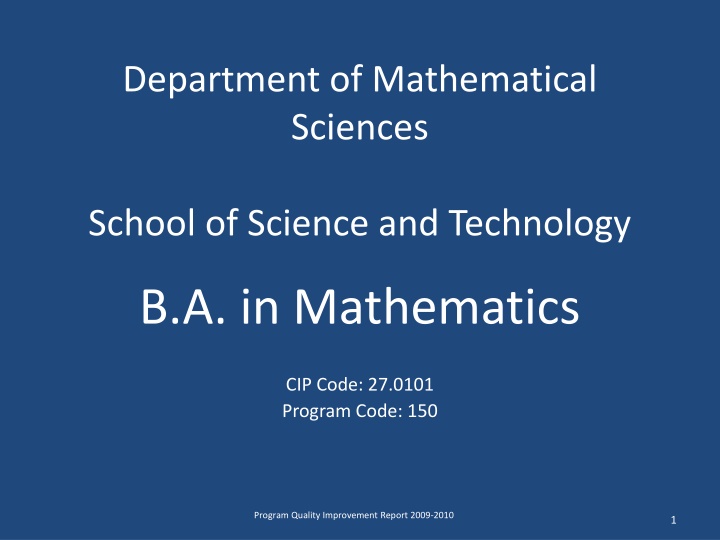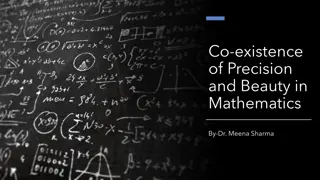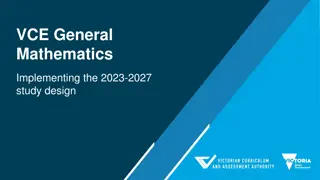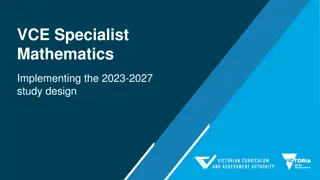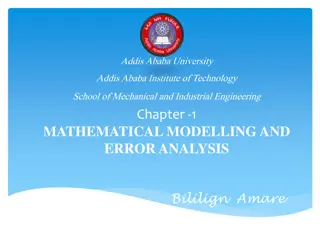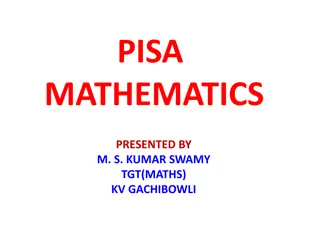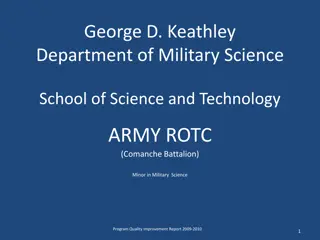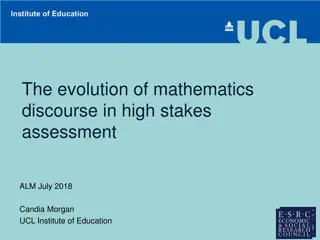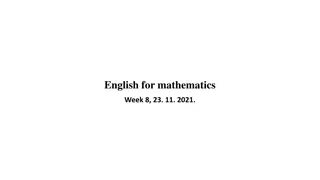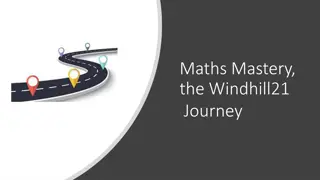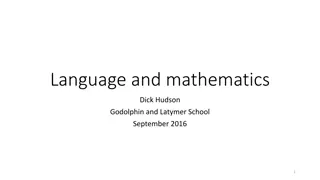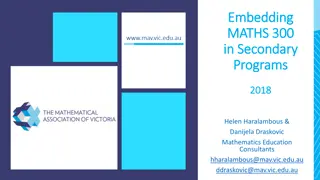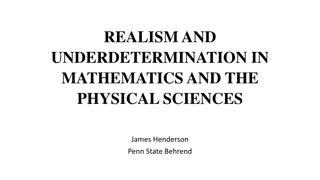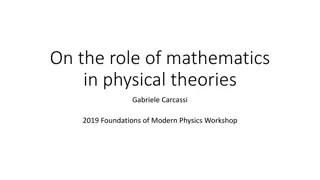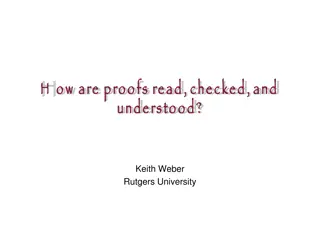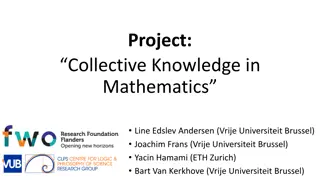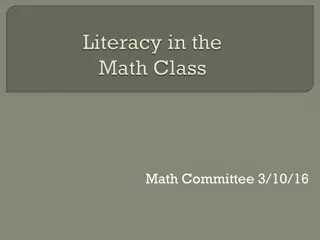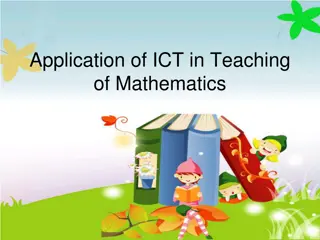Mathematics Program Quality Improvement Report 2009-2010 at Department of Mathematical Sciences
This report outlines the student-learning outcomes of the Mathematics program at the Department of Mathematical Sciences. It covers areas such as knowledge of mathematical content, reasoning and proof, mathematical representation and problem-solving, mathematical communication, and knowledge of technology. The alignment of learning outcomes with Cameron University's mission statement is emphasized, focusing on providing quality educational opportunities, preparing students for success, and encouraging lifelong learning and contributions to society.
Download Presentation

Please find below an Image/Link to download the presentation.
The content on the website is provided AS IS for your information and personal use only. It may not be sold, licensed, or shared on other websites without obtaining consent from the author.If you encounter any issues during the download, it is possible that the publisher has removed the file from their server.
You are allowed to download the files provided on this website for personal or commercial use, subject to the condition that they are used lawfully. All files are the property of their respective owners.
The content on the website is provided AS IS for your information and personal use only. It may not be sold, licensed, or shared on other websites without obtaining consent from the author.
E N D
Presentation Transcript
Department of Mathematical Sciences School of Science and Technology B.A. in Mathematics CIP Code: 27.0101 Program Code: 150 Program Quality Improvement Report 2009-2010 1
Student-Learning Outcomes 1. Knowledge of Mathematical Content 1.a. Demonstrate a conceptual understanding of and procedural facility with basic calculus concepts. 1.b. Apply concepts from algebra, geometry, and trigonometry in solving problems involving calculus. 1.c. Use the principles of multiple variable calculus. 1.d. Apply basic set operations. 1.e. Apply basic propositional and predicate logic. 1.f. Use the concepts of relation and equivalence relation. 1.g. Apply fundamental ideas of linear algebra. 1.h. Demonstrate competency with ordinary differential equations and their applications. 1.i. Apply the concept of sequence & infinite series. 1.j. Apply major concepts of abstract algebra. 1.k. Analyze functions of one and two variables. 2 Program Quality Improvement Report 2009-2010
Student-Learning Outcomes 2. Knowledge of Reasoning and Proof. 2.a. Develop and evaluate mathematical arguments and proofs. 2.b. Select and use various types of reasoning and methods of proof. 3. Knowledge of Mathematical Representation and Problem Solving 3.a. Solve problems that arise in mathematics and those involving mathematics and other contexts. 3.b. Select, apply and translate among mathematical representations to solve problems. 4. Knowledge of Mathematical Communication 4.a. Communicate mathematical thinking coherently and clearly to peers, faculty and others. 4.b. Use the language of mathematics to express ideas precisely. 3 Program Quality Improvement Report 2009-2010
Student-Learning Outcomes 5. Knowledge of Technology 5.a. Use knowledge of mathematics to select and use appropriate technological tools, such as, but not limited to, graphing calculators and computer algebra systems (e.g. Mathematica and MATLAB). 5.b. Solve problems using an object oriented programming language and its corresponding operating system. 4 Program Quality Improvement Report 2009-2010
Alignment of Learning Outcomes Alignment with Cameron University's Mission Statement Cameron University provides a diverse and dynamic student body access to quality educational opportunities; prepares students for professional success, responsible citizenship, life-long learning, and meaningful contributions to a rapidly changing world ... Dissemination of knowledge Appreciation of mathematics Beauty of mathematics in solving real world application problems Strong foundation of mathematics for acquiring knowledge, skills, and attitudes for a lifetime of learning Graduates pursue graduate studies or obtain careers in private or government sectors 5 Program Quality Improvement Report 2009-2010
Alignment of Learning Outcomes Alignment with School of Science and Technology s Mission Statement The mission of the Cameron University School of Science and Technology is to educate students in an intellectual atmosphere based on excellence in academic work, to deliver student support which gives our students the skills and confidence to excel as lifelong learners; to ensure success of graduates in a diverse and ever- changing environment; and to support community efforts relevant to the School mission. Strong knowledge base and quantitative skills Gain useful skills as well as an appreciation for the subject Tutoring opportunities Internship opportunities 6 Program Quality Improvement Report 2009-2010
Alignment of Learning Outcomes Alignment with Department of Mathematical Sciences Mission Statement The mission of the Mathematical Sciences Department at Cameron University is to provide quality educational experiences in all mathematics and statistics courses provide all students, both majors and non-majors, with the knowledge and skills needed for life-long learning, as well as an appreciation for the beauty and power of mathematics majors will acquire a broad and solid base in mathematics, enabling them to continue their education in graduate school or to pursue careers in teaching, industry, or government. Mathematical knowledge and skills needed to excel in their desired academic program Appreciation for the beauty and power of mathematics 7 Program Quality Improvement Report 2009-2010
Alignment of Learning Outcomes Alignment with Cameron University s Strategic Plan Tools necessary for graduates to successfully compete in the job market both today and into the future Familiarity with present technologies Ability to communicate mathematics effectively Solid foundation in mathematics Tutoring opportunities Internship opportunities 8 Program Quality Improvement Report 2009-2010
Program Assessment Measures Direct Measures Entry-level Assessment Calculus and Analytical Geometry Final Questions Technology for Mathematics Assessment Mid-level Assessment Mid-level Assessment Exam Technology for Advanced Mathematical Assessment Upper-level Assessment Major Field Achievement Test Differential Equations Assessment 9 Program Quality Improvement Report 2009-2010
Program Assessment Measures Indirect Measures The Written Survey of Graduates 10 Program Quality Improvement Report 2009-2010
Report on Previously Chosen Priority Outcomes Learning Outcome 1.a Demonstrate a conceptual understanding of and procedural facility with basic calculus concepts. This outcome is assessed by all of the assessments presently developed, but we chose to focus upon the entry-level assessment in MATH2215 Calculus & Analytical Geometry I. 11 11 Program Quality Improvement Report 2009-2010
Report on Previously Chosen Priority Outcomes Learning Outcome 1.a A pre-test was developed and administered in all Calculus I and Elementary Calculus courses to assess the students' ability with algebra and trigonometry (Calculus I only). Based upon the results of this pre-test, students demonstrating serious deficiencies in these areas were then to be referred to the Mathematics Laboratory for additional help and were to meet with the instructor of the course during office hours to improve their skills. 12 12 Program Quality Improvement Report 2009-2010
Report on Previously Chosen Priority Outcomes Learning Outcome 1.b Apply concepts from algebra, geometry, and trigonometry in solving problems involving calculus. This outcome is assessed by most of the assessments given, but was chosen to be part of the previous outcome, since both were chosen to be part of the improvements to MATH2215. 13 13 Program Quality Improvement Report 2009-2010
Report on Previously Chosen Priority Outcomes Learning Outcome 2.b Select and use various types of reasoning and methods of proof. This outcome was not assessed by any of the assessments, so was chosen so an assessment could be developed. 14 14 Program Quality Improvement Report 2009-2010
Report on Previously Chosen Priority Outcomes Learning Outcome 2.b Proofs are presently being collected from all students in a particular class in order to evaluate the class as a whole. 15 15 Program Quality Improvement Report 2009-2010
Student-learning Outcome and Measurements Outcome 1.b MEASUREMENTS OF STUDENT LEARNING OR SERVICE OUTCOME Methods used to determine validity of measurement instruments Methods used to determine reliability of measurements CURRICULUM AREA OR TARGET AUDIENCE PROGRAM OUTCOME Schedule for measurements Measurements 1.b. Apply concepts from algebra, geometry, and trigonometry in solving problems involving calculus Required courses MATH 2215 MATH 2235 MATH 2244 MATH 4483 Entry level Embedded questions in final for MATH 2215 Questions were developed by subcommittee of faculty to align with learning outcome (Entry level and Mid level) Questions are determined to be correct or not (only one correct answer) MATH 2215 Every semester Mid level Questions on mid- level assessment test given in MATH 2613 MATH 2613 Every Fall semester MATH 4483 Every Spring semester Upper level MFT MFT is nationally normed tested From ETS 16 16 Program Quality Improvement Report 2009-2010
Student-learning Outcome and Measurements Outcome 1.b Entry-level Assessment Number and Percentage of Students Scoring in Each Category Fall 2007 Sum 2008 (41 total) Fall 2008- Sum 2009 (70 total) Fall 2009- Sum 2010 (80 Total) Learning Outcome Task Matching Correct Interpretation for Integrals 3 or 2 correct Correct Interpretation for Derivatives 5 or 4 correct Correct Differential Equation Correct Rate of Change Correct Area Evaluated Limit Correctly 1.b. 34 (83%) 41 (59%) 62 (78%) 38 (93%) 42 (60%) 67 (84%) 29 (71%) 21 (51%) 29 (71%) 27 (66%) 27 (39%) 18 (26%) 7 (10%) 4 (6%) 48 (60%) 41 (51%) 40 (50%) 36 (45%) 17 Program Quality Improvement Report 2009-2010
Student-learning Outcome and Measurements Outcome 1.b Mid-level Assessment Percentage of Students Scoring in Each Category Percent of correct answers n =14 Percent of correct answers n=18 Percent of correct answers n=13 Percent of correct answers n=13 Learning Outcome Apply concepts from algebra, geometry and trigonometry in solving problems involving calculus (1.b.) * Fall 2006 Fall 2007 Fall 2008 Fall 2009 43% 50% 46% 54% *Two additional questions were added covering this learning outcome for the Fall 2007 test. 18 Program Quality Improvement Report 2009-2010
Student-learning Outcome and Measurements Outcome 1.b Mid-level Assessment Exam Percentage of Students Scoring in Each Category Does Not Meet Standards Meets Standards Exceeds Standards Total 1.b. Fall 2007 (n=18) Fall 2008 (n=13) Fall 2009 (n=14) 50% 38% 29% 33% 54% 57% 17% 8% 14% 100% 100% 100% 19 Program Quality Improvement Report 2009-2010
Student-learning Outcome and Measurements Outcome 1.b Major Field Achievement Test Average and National Percentages for Students Scoring in Each Category Scores are formatted as follows: Average of Raw Scores (Percentage of National Average) Overall 1.b: Calculus Indicator Spring 2005 (n=18) 149.2 (35%) 30.1 (30%) Spring 2006 (n=16) 145.7 (10%) 29.3 (20%) Spring 2007 (n=6) 140.0 (1%) 31.0 (25%) Spring 2008 (n=7) 159.0 (65%) 37.0 (60%) Spring 2009 (n=8) 151.0 (30%) 33.0 (35%) Spring 2010 (n=9) 151.0 (40%) 31.0 (25%) 20 Program Quality Improvement Report 2009-2010
Student-learning Outcome and Measurements Outcome 1.b MFT Multi-Year Trend Analysis for Percentiles 70 60 Overall 1.b 50 Percentage 40 30 20 10 0 2005 2006 2007 2008 2009 2010 Year 21 Program Quality Improvement Report 2009-2010
Student-learning Outcome and Measurements Outcome 1.b Differential Equation Project Percentage of Students Successfully Completing Each Criteria Criteria Spring 2008 (n=7) Spring 2009 (n=13) Spring 2010 (n=16) (Along with objective tested.) Initial Value Problems are correctly evaluated. (1.a.) 100% 100% 100% Analytical differentiation is successfully carried out. (1.a.) Analytical integration is successfully carried out. (1.a.) 100% 100% 100% 100% 100% 100% 22 Program Quality Improvement Report 2009-2010
Action Plan for Student-Learning Outcome Outcome 1.b The initial results of the calculus pre-test determined that a surprising majority of students were deficient in their ability to solve the problems given on the pre-test. In discussing these results, the consensus was to forego the pre-test and instead focus on addressing these issues in College Algebra by instituting a common final exam to be used in all sections of College Algebra. This will be used to ensure a uniform level of knowledge and understanding between all sections and may be expanded in the future to the remedial algebra courses. 23 Program Quality Improvement Report 2009-2010
Student-learning Outcome and Measurements Outcome 2.b MEASUREMENTS OF STUDENT LEARNING OR SERVICE OUTCOME Methods used to determine validity of measurement instruments Methods used to determine reliability of measurements CURRICULUM AREA OR TARGET AUDIENCE PROGRAM OUTCOME Schedule for measurements Measurements 2.b. Select and use various types of reasoning and methods of proof MATH2613 MATH3013 MATH3213 MATH3302 MATH3613 MATH4423 MATH4483 None currently Please see action plan 24 24 Program Quality Improvement Report 2009-2010
Action Plan for Student-Learning Outcome Outcome 2.b Develop a rubric to assess the proofs collected in Foundations of Mathematics (MATH 2613), Linear Algebra (MATH 3013), Abstract Algebra (MATH 3213) and Introduction to Real Analysis (MATH 4483). This rubric will then be used by a faculty member who is not teaching the respective course to grade the proofs. Data collected will be analyzed to determine students performance on learning outcome 2.b. 25 Program Quality Improvement Report 2009-2010
Student-learning Outcome and Measurements Outcome 5.a MEASUREMENTS OF STUDENT LEARNING OR SERVICE OUTCOME Methods used to determine validity of measurement instruments Methods used to determine reliability of measurements CURRICULUM AREA OR TARGET AUDIENCE PROGRAM OUTCOME Schedule for measurements Measurements 5.a. Use knowledge of mathematics to select and use appropriate technologies tools, such as, but not limited to, graphing calculators or computer algebra systems (e.g. Mathematica and MATLAB) MATH1001 MATH2215 MATH3001 MATH3013 MATH3302 MATH4113 MATH4433 STAT3023 STAT3113 None currently Please see action plan 26 26 Program Quality Improvement Report 2009-2010
Action Plan for Student-Learning Outcome Outcome 5.a With the approval of MATH 1001 and MATH 3001, assessments are still needed for these classes in order to measure how well students are meeting objective 5.a. These assessments will likely have to be tailored to the particular technology used. 27 Program Quality Improvement Report 2009-2010
Published information on graduates Entered Graduate School Working In Discipline Other Academic Year 09-10 0 2 0 Summer 2009 0 1 1 Fall 2009 0 2 0 Spring 2010 0 5 1 Total 28 Program Quality Improvement Report 2009-2010
Questions? 29 Program Quality Improvement Report 2009-2010
